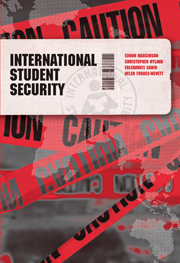PART 2 - Security in the formal and public domain
Published online by Cambridge University Press: 05 August 2012
Summary
INTRODUCTION TO PART 2: THE FORMAL AND PUBLIC DOMAIN
The formal and public domain of international student security in Australia is constituted by the ESOS Act, which defines in a particular way the relationship between nation-state, institutional providers and the student consumer. It is also shaped by the conditions governing student visas; and affected by higher education policy and funding, and processes of accreditation and quality assurance (not discussed in detail here).
The branch of government with specific policy responsibility is Australian Education International (AEI), located in the federal Department of Education, Employment and Workplace Relations (DEEWR). AEI promotes the industry, though individual institutions also carry out their own marketing. It administers the ESOS Act and its website is the main official source of information. For the most part AEI relates to students indirectly via educational providers. The National Code of Practice for Registration Authorities and Providers of Education and Training to Overseas Students is addressed to providers, not students. Government at a distance means state authority is curiously diffuse. On most matters the students have little recourse to direct demands, confrontation or even questions of government. As much as possible questions of standards and quality are transferred down to their dealings with providers. This is consistent with the principles of subsidiary (devolution to the level closest to the actual service) and academic autonomy, but there is no mechanism of appeal beyond the provider. Nor in most areas are there solid standards by which AEI can be held to account.
- Type
- Chapter
- Information
- International Student Security , pp. 81 - 88Publisher: Cambridge University PressPrint publication year: 2010

